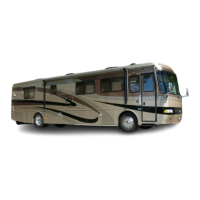and hold test button for three seconds. Indicator light
will illuminate while test button is depressed.
• After releasing test button, indicator lamp will turn
off and blink code will be displayed: 1-1 will indi-
cate no system faults.
The motorhome air braking system is equipped with several back-up
safety systems and warning alarms in the event of an air system failure.
Refinements to air braking systems have been instituted with safety as top
priority. For example: should the air compressor fail to charge the air system
and the low air gauge readings go undetected, a low air pressure warning
buzzer will sound and low air pressure dash warning indicator lamp will illu-
minate. These warning indicators occur at approximately 65 psi. This will
alert the operator of an impending situation. If the motorhome is allowed
continued operation the pneumatic emergency spring brake relay valve
installed in the air system senses the low air pressure condition. The emer-
gency spring brake relay valve will release the air charge from the spring
brake air chambers on the rear drive axle. In this case the park brakes will
automatically apply at approximately 30 psi. This safety back-up system acts
as an automatic emergency brake system.
Another back up safety is the air system separation of the front and rear
brakes, implemented by using two air tanks. One tank is located in the front
and the other is located in the rear. This separation allows the front air tank
to operate the front brake. The rear tank operates the rear drive axle brakes
and tag axle brakes if equipped with a tag axle. This tank division gives
reassurance in the event of one tank having a failure of an accessory air item
allowing the compressed air to escape. Accessory air items are other
pneumatically operated items such as the air horn, step well cover, vacuum,
generator, etc. The accessory air items operate only when air tank pressures
exceed 65 psi. This is done with pressure protection valves. Should an
accessory air item fail, the pressure protection valve (PPV) will reserve
remaining air pressure of 65 psi for braking. This will leave the motorhome
with one air tank fully charged for a safety back up.
Another situation, in which all compressed air has escaped from the rear
air tank, a pneumatic back-up safety valve is installed. This is the safety
inversion valve. The inversion valve senses the absence of rear air tank
pressure. In this case the inversion valve will allow the operator to make a
modulated spring brake application, made in conjunction with the emergency
spring brake relay valve. The inversion valve allows the front air tank
pressure to recharge the rear brake chambers after the modulated spring
brake application has been made. This back-up system allows use of all the
brakes, allowing the operator to bring the vehicle to a safe stop. In the event
of all compressed air charge escaping from the front air tank the operator
will still have full use of the rear brakes.
Chassis Information
------------------------------------------------------------------------------------------------------------------------------------------------------------------------------------------------------------------------------------------------------------------------------------------------------------------
WINDSOR
10•269
BRAKE SYSTEMS -
Back Up

